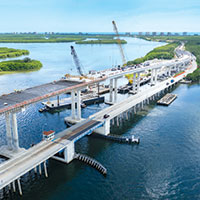 Tale of 2 bridges: Building new span easier than fixing old
Tale of 2 bridges: Building new span easier than fixing old
STORY BY STEVEN M. THOMAS (Week of August 14, 2025)
Turns out it is quicker to build a massive new bridge from scratch than to repair one that is nearly 50 years old.
As Vero Beach residents know all too well, the Alma Lee Loy Bridge, which carries 17th Street over the Indian River lagoon, has been a construction site for more than five years, and traffic will be winding around barricades and orange barrels for at least another year and half.
Meanwhile, at the south end of the island, a team of engineers and contractors working for the Florida Department of Transportation have spanned the waterway with a new modern concrete and steel structure in just over two years.
Work began on the new tall bridge in May 2023 and “by June 30, 2025, all bridge beams from the eastern end of the bridge were successfully installed over the waterway, marking a significant milestone in the construction process,” according to FDOT’s Samantha Kayser.
There is still a lot of work to do on the soaring structure – which will open to traffic next year, while Alma Lee Loy repairs are still puttering along – but by the end of June, construction workers could walk across the wide lagoon on the bones of the new bridge.
Besides going up quickly compared to the repair timeline on the 17th Street bridge, the new bridge is expected to last much longer – 75 years instead of 50, which was the standard when the Vero bridge was built in the 1970s, according to Mike Sileno, engineer of record for the southern bridge.
As it rises from the longtime route of Highway A1A on the island, the 4,100-foot-long bridge makes a sweeping curve to the right, steering clear of the old drawbridge it is replacing. Straightening out, it rises to a height of 85 feet, 20 feet taller than the 17th Street bridge.
At the western end in Fort Pierce, it will fly over Old Dixie Highway and the busy Florida East Coast Railway tracks that Brightline runs on to meet U.S. 1 at level.
For decades, drivers turning off of U.S. 1 headed for the island went down a steep hill, crossed Dixie Highway, bumped over the railroad tracks and then went steeply back up onto the existing drawbridge, which was built when John F. Kennedy was president. The new bridge eliminates that dip.
Besides one 12-foot vehicle lane in each direction, the 65-foot-wide bridge will have two 8-foot bike lanes, a barrier protected 8-foot sidewalk on the south side, and a barrier-protected 12-foot shared use path on the north side that will carry the East Coast Greenway over the water. There will also be a 300-foot observation deck.
The first new bridge built in 30 years between the island and the mainland and one of the highest bridges on the East Coast of Florida, the rapidly evolving structure has a monumental quality, seen up-close or in aerial photos.
When complete, the project of which it is the centerpiece will have consumed more than half a billion pounds of material – which amounts to more than 250,000 tons of earth, concrete and steel.
That includes 143,000 cubic yards of rock and earth weighing approximately 400 million pounds, 28,000 cubic yards of concrete weighing 112 million pounds, and almost 7 million pounds of steel.
The massive bridge footings, piers and main structural cross beams were all poured in place amid sometimes wild weather and an ever-changing marine environment.
Most of the precast concrete I-beams that span the gaps between the piers and will support the roadbed were manufactured right here in Indian River County by CDS Manufacturing at a 15-acre site on the south side of route 60, just past the route 512 intersection.
“The longest beams are 182 feet and weigh 110 tons,” said senior project engineer Bill Stuckey.
Sileno told Vero Beach 32963 that it took more than five years to design the bridge, starting in 2016 and finishing in 2021, and said the plan set includes more than 2,000 pages of drawings and specifications.
The bridge is projected to last 50 percent longer than older bridges built in the prior century mainly because of advances in material science that have resulted in more durable, “high performance” concrete and better coatings, according to Sileno.
Polymers and ultrafine particles make the new concrete less porous and more resistant to saltwater corrosion, while carbon fiber reinforcement materials supplement the traditional rebar used to strengthen the concrete.
Better design also contributes to longevity, according to Stuckey, who said older bridges had lower parts that were in the saltwater “splash zone,” where stormy waters could bathe them in corrosive chloride. The lowest part of the new bridge is 12 feet above the wavetops.
Besides its own engineers and project managers, FDOT has two high-powered engineering firms at work on the bridge.
Bridge designer Sileno and his team are with H&H, formerly Hardesty & Hanover, which was founded by 1887 by the inventor of the vertical lift bridge and has been designing major bridges of all types around the world for nearly 140 years.
Stuckey and his team are employees of Stantec, a global leader in sustainable engineering, architecture and environmental consulting with 32,000 employees in more than 20 countries on six continents.
H&H designed the bridge and continues to consult as the construction process proceeds, while Stantec oversees quality and plan compliance, with four or five inspectors on site daily, some of them young engineers and others who are veterans of many bridge projects with as much as 30 years’ experience helping solve problems and monitoring material and construction quality.
Teams from both companies meet weekly with FDOT engineers and managers and representatives of the construction company to sort out any problems and make sure the job stays on track – which it has done so far to a remarkable degree.
Bridge general contractor Vecellio & Grogan is as impressive as the engineering firms. A fourth-generation family business with roots going back to 1900, when Enrico Vecellio began a masonry contracting business in West Virginia, the company has 120 years of heavy highway and bridge construction under its belt.
“We figured 1,357 working days to begin with, and it now looks like it will be about 1,400,” said Stuckey, who hopes to see traffic flowing back and forth across the new bridge by this time next year.
“We have to be cautious, so our official timeline for the bridge opening is late next year, but we hope to have it done earlier in the year, and the way it is going, we may be able to. Every time we do an update and put out new photos, people say “wow,” and are impressed by how well it’s going,” Stuckey said.
The complete North Causeway Bridge project is now expected to cost $115 million, up from an original estimate $79 million – which isn’t bad in a period when many big construction and infrastructure projects have doubled in cost due to inflation and other factors.
Once the new bridge is open to traffic the 1962 drawbridge will be torn down and hauled away, taking some Old Florida atmosphere with it to the scrap yard.
The overall project, which extends 1.2 miles from Little Jim Bait and Tackle on the island to U.S. 1, includes old bridge demolition, extensive drainage work, rerouting and repaving roads at both ends of the bridge, installation of signage and signal lights and other tasks. It is slated for completion in late 2027.
With any luck, repairs on the Alma Lee Loy Bridge will be complete by that time, too.
Begun in 1977 and completed in 1979, the Vero bridge was nearing the end of its projected life when problems were detected. The structure was found to be in critical condition in 2018 and deemed structurally deficient in 2020.
FDOT made the decision to repair the bridge instead of replacing it, which may have saved as much as $100 million, but also stretched the construction timeline out toward infinity.
By the time it is finished in 2027, as it surely must be for the sanity of island residents, it will have taken three times as long to repair the bridge as it did to build it back in the days of the Camp David Accords and Iranian hostage crisis.



